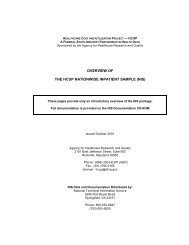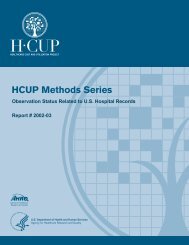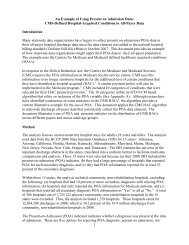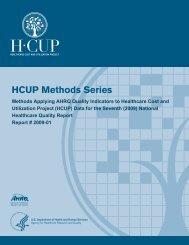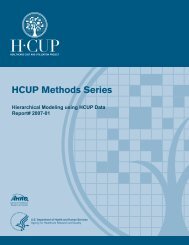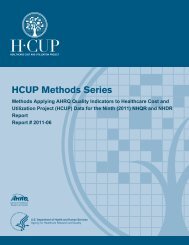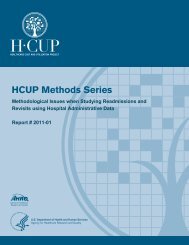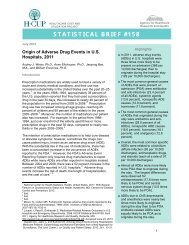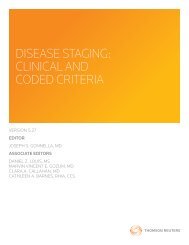HCUP Methods Series - Agency for Healthcare Research and Quality
HCUP Methods Series - Agency for Healthcare Research and Quality
HCUP Methods Series - Agency for Healthcare Research and Quality
Create successful ePaper yourself
Turn your PDF publications into a flip-book with our unique Google optimized e-Paper software.
INTRODUCTION TO THE CLINICAL CLASSIFCIATIONS SOFTWARE (CCS)2004 User's GuideOverviewClinical Classifications Software provides a way to classify diagnoses <strong>and</strong> proceduresinto a limited number of categories. CCS aggregates individual ICD-9-CM codes intobroad diagnosis <strong>and</strong> procedure groups <strong>for</strong> statistical analysis <strong>and</strong> reporting. Thisdocument provides a description of the CCS categorization scheme. Electronic filescontaining the translation of ICD-9-CM diagnosis <strong>and</strong> procedure codes into CCScategories can be downloaded from this site. (CCS was <strong>for</strong>mally called CCHPR, ClinicalClassifications <strong>for</strong> Health Policy <strong>Research</strong>.)CCS is continually updated. The current version is based on ICD-9-CM codes that arevalid <strong>for</strong> January 1980 through September 2004. CCS consists of two relatedclassification systems. The first system, called the single level CCS, groups diagnosesinto mutually exclusive categories. The single-level diagnosis CCS aggregates illnesses<strong>and</strong> conditions into 260 mutually exclusive categories. Similarly, the single-levelprocedure CCS aggregates procedures into 231 mutually exclusive categories, most ofwhich are homogeneous.The second system exp<strong>and</strong>s the single-level CCS into a hierarchical system, called themulti-level CCS. The multi-level CCS groups single-level CCS categories into broadercategories (e.g., Infectious Diseases, Mental Disorders, <strong>and</strong> Injury). It also splits singlelevelCCS categories to provide more detail about particular groupings of codes.CCS documentation provides a listing of which ICD-9-CM codes are included in eachCCS diagnosis <strong>and</strong> procedure category.PurposeCCS categories can be employed in many types of projects analyzing data on diagnoses<strong>and</strong> procedures. For example, they can be used to:♦ identify cases <strong>for</strong> disease-specific or procedure-specific studies;♦ gain a better underst<strong>and</strong>ing of an institution's or health plan's distribution of patientsacross disease or procedure groupings;♦ provide statistical in<strong>for</strong>mation on characteristics, such as charges <strong>and</strong> length of stay,about relatively specific conditions;♦ cross-classify procedures by diagnoses to provide insight into the variety ofprocedures per<strong>for</strong>med <strong>for</strong> particular diagnoses.Diagnoses <strong>and</strong> procedures <strong>for</strong> hospital inpatient stays are coded using the InternationalClassification of Diseases, 9th Revision, Clinical Modification (ICD-9-CM), Fifth Edition(Public Health Service <strong>and</strong> Health Care Financing Administration, 1994). ICD-9-CMconsists of about 12,000 diagnosis codes <strong>and</strong> 3,500 procedure codes. Although it ispossible to present descriptive statistics <strong>for</strong> individual ICD-9-CM codes, it is often usefulto aggregate codes into clinically meaningful categories that group similar conditions orprocedures. For examples of the use of CCS categories, see Elixhauser <strong>and</strong> Steiner<strong>HCUP</strong> CCS 6/16/2004 3



